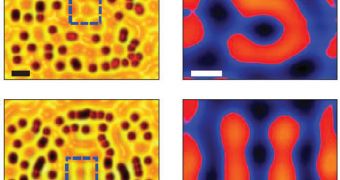Researchers at the Stanford University might have just made the day for businesses seeking to fool people with fine print portions in the contract. They have created letters approximately 15 nm tall, using a device known as a scanning tunneling microscope (STM) to push individual carbon monoxide molecules onto a copper surface. The team is not the first to design small letters, as attempts with this aim have been made since as early as 1990, by IBM researchers using the same technique.
Christopher Moon and Hari Manoharan, the two Stanford researchers behind the project, used STM to arrange the carbon monoxide molecules in a very specific pattern on the copper surface. The atoms were ordered in a circular fashion, with a hole in the middle. A flow of electrons was fired at the copper support, which created a ripple effect in between the existing atoms. These were pushed aside, and a holographic projection of the letters became visible in the space between them (see image).
"Imagine [the copper as] a very shallow pool of water into which we put some rocks [the carbon monoxide molecules]. The water waves scatter and interfere off the rocks, making well defined standing wave patterns," Manoharan explains. If the "rocks" are placed just right, then the shapes of the waves will form any letters in the alphabet, the researchers say.
Thus far, the team has manged to produce an "S," an "U," and an "SU" couple, standing for the initials of Stanford University. They followed the example of researchers Donald Eigler and Erhard Schweizer, who in 1990 used STM to write the initials "IBM" on a nickel surface. Their project only required 35 xenon atoms, which were pushed on the surface of the nickel to create letters 5nm tall.
In 1991, Japanese researchers managed to chisel 1.5 nm-tall characters onto a molybdenum disulphide crystal, using the same scanning tunneling microscope technique. At the time, Hitachi set the record for the smallest microscopic calligraphy ever designed. The Stanford effort reached this record, but failed to surpass it. However, it did bring innovation. Instead of fixing the letters onto a support, it created them holographically, which was an impressive step forward.

 14 DAY TRIAL //
14 DAY TRIAL //